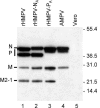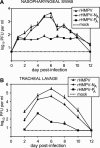Chimeric recombinant human metapneumoviruses with the nucleoprotein or phosphoprotein open reading frame replaced by that of avian metapneumovirus exhibit improved growth in vitro and attenuation in vivo
- PMID: 16306583
- PMCID: PMC1316028
- DOI: 10.1128/JVI.79.24.15114-15122.2005
Chimeric recombinant human metapneumoviruses with the nucleoprotein or phosphoprotein open reading frame replaced by that of avian metapneumovirus exhibit improved growth in vitro and attenuation in vivo
Abstract
Chimeric versions of recombinant human metapneumovirus (HMPV) were generated by replacing the nucleoprotein (N) or phosphoprotein (P) open reading frame with its counterpart from the closely related avian metapneumovirus (AMPV) subgroup C. In Vero cells, AMPV replicated to an approximately 100-fold-higher titer than HMPV. Surprisingly, the N and P chimeric viruses replicated to a peak titer that was 11- and 25-fold higher, respectively, than that of parental HMPV. The basis for this effect is not known but was not due to obvious changes in the efficiency of gene expression. AMPV and the N and P chimeras were evaluated for replication, immunogenicity, and protective efficacy in hamsters. AMPV was attenuated compared to HMPV in this mammalian host on day 5 postinfection, but not on day 3, and only in the nasal turbinates. In contrast, the N and P chimeras were reduced approximately 100-fold in both the upper and lower respiratory tract on day 3 postinfection, although there was little difference by day 5. The N and P chimeras induced a high level of neutralizing serum antibodies and protective efficacy against HMPV; AMPV was only weakly immunogenic and protective against HMPV challenge, reflecting antigenic differences. In African green monkeys immunized intranasally and intratracheally, the mean peak titer of the P chimera was reduced 100- and 1,000-fold in the upper and lower respiratory tracts, whereas the N chimera was reduced only 10-fold in the lower respiratory tract. Both chimeras were comparable to wild-type HMPV in immunogenicity and protective efficacy. Thus, the P chimera is a promising live HMPV vaccine candidate that paradoxically combines improved growth in vitro with attenuation in vivo.
Figures




Similar articles
-
Deletion of M2 gene open reading frames 1 and 2 of human metapneumovirus: effects on RNA synthesis, attenuation, and immunogenicity.J Virol. 2005 Jun;79(11):6588-97. doi: 10.1128/JVI.79.11.6588-6597.2005. J Virol. 2005. PMID: 15890897 Free PMC article.
-
Recombinant human Metapneumovirus lacking the small hydrophobic SH and/or attachment G glycoprotein: deletion of G yields a promising vaccine candidate.J Virol. 2004 Dec;78(23):12877-87. doi: 10.1128/JVI.78.23.12877-12887.2004. J Virol. 2004. PMID: 15542640 Free PMC article.
-
Chimeric subgroup A respiratory syncytial virus with the glycoproteins substituted by those of subgroup B and RSV without the M2-2 gene are attenuated in African green monkeys.Virology. 2001 Apr 25;283(1):59-68. doi: 10.1006/viro.2001.0894. Virology. 2001. PMID: 11312662
-
Live vaccines for human metapneumovirus designed by reverse genetics.Expert Rev Vaccines. 2006 Oct;5(5):695-706. doi: 10.1586/14760584.5.5.695. Expert Rev Vaccines. 2006. PMID: 17181442 Review.
-
Vaccination approaches to combat human metapneumovirus lower respiratory tract infections.J Clin Virol. 2008 Jan;41(1):49-52. doi: 10.1016/j.jcv.2007.10.022. Epub 2007 Dec 4. J Clin Virol. 2008. PMID: 18054841 Review.
Cited by
-
A live attenuated human metapneumovirus vaccine strain provides complete protection against homologous viral infection and cross-protection against heterologous viral infection in BALB/c mice.Clin Vaccine Immunol. 2013 Aug;20(8):1246-54. doi: 10.1128/CVI.00145-13. Epub 2013 Jun 12. Clin Vaccine Immunol. 2013. PMID: 23761661 Free PMC article.
-
Frequent frameshift and point mutations in the SH gene of human metapneumovirus passaged in vitro.J Virol. 2007 Jun;81(11):6057-67. doi: 10.1128/JVI.00128-07. Epub 2007 Mar 21. J Virol. 2007. PMID: 17376897 Free PMC article.
-
Aberrant T cell immunity triggered by human Respiratory Syncytial Virus and human Metapneumovirus infection.Virulence. 2017 Aug 18;8(6):685-704. doi: 10.1080/21505594.2016.1265725. Epub 2016 Dec 2. Virulence. 2017. PMID: 27911218 Free PMC article. Review.
-
Modulation of Host Immunity by the Human Metapneumovirus.Clin Microbiol Rev. 2016 Oct;29(4):795-818. doi: 10.1128/CMR.00081-15. Clin Microbiol Rev. 2016. PMID: 27413096 Free PMC article. Review.
-
Negative-Strand RNA Virus-Vectored Vaccines.Methods Mol Biol. 2024;2786:51-87. doi: 10.1007/978-1-0716-3770-8_3. Methods Mol Biol. 2024. PMID: 38814390 Review.
References
-
- Belshe, R. B., F. K. Newman, T. F. Tsai, R. A. Karron, K. Reisinger, D. Roberton, H. Marshall, R. Schwartz, J. King, F. W. Henderson, W. Rodriguez, J. M. Severs, P. F. Wright, H. Keyserling, G. A. Weinberg, K. Bromberg, R. Loh, P. Sly, P. McIntyre, J. B. Ziegler, J. Hackell, A. Deatly, A. Georgiu, M. Paschalis, S. L. Wu, J. M. Tatem, B. Murphy, and E. Anderson. 2004. Phase 2 evaluation of parainfluenza type 3 cold passage mutant 45 live attenuated vaccine in healthy children 6-18 months old. J. Infect. Dis. 189:462-470. - PubMed
-
- Biacchesi, S., Q. N. Pham, M. H. Skiadopoulos, B. R. Murphy, P. L. Collins, and U. J. Buchholz. 2005. Infection of nonhuman primates with recombinant human metapneumovirus lacking the SH, G, or M2-2 protein categorizes each as a nonessential accessory protein and identifies vaccine candidates. J. Virol. 79:12608-12613. - PMC - PubMed
-
- Biacchesi, S., M. H. Skiadopoulos, G. Boivin, C. T. Hanson, B. R. Murphy, P. L. Collins, and U. J. Buchholz. 2003. Genetic diversity between human metapneumovirus subgroups. Virology 315:1-9. - PubMed
MeSH terms
Substances
LinkOut - more resources
Full Text Sources
Other Literature Sources

